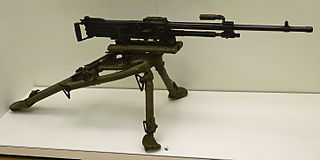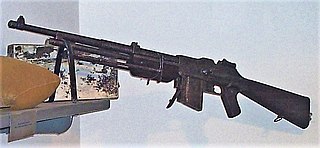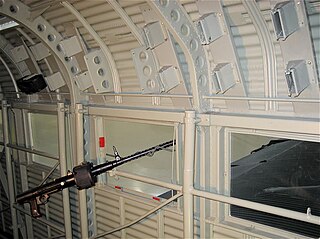 W
WThe Alfa M44 was a Spanish machine gun developed during World War II. At this time, stocks of machine guns ran low and no outside source was available. Non-combatant nations found that the belligerent nations were unable to supply as they were preoccupied with meeting their own wartime production needs. It complimented the ZB-26 light machine gun, and replaced the aging Hotchkiss M1914 machine gun. Originally chambered in 7.92×57mm Mauser, in 1955 an updated version chambered in 7.62×51mm NATO was introduced, and was subsequently issued to Spanish troops, sometimes referred to as the M55. Along with Spain, the M44 was also prominently used by Egypt, whose army had standardised on the 7.92×57mm Mauser round.
 W
WThe Besa machine gun was a British version of the Czechoslovak ZB-53 air-cooled, belt-fed machine gun.
 W
WThe Browning wz.1928 is a Polish version of the M1918 BAR. It was a light machine gun used by the Poles in World War II.
 W
WCkm wz. 30 is a Polish-made clone of the American Browning M1917 heavy machine gun. Produced with various modifications such as greater caliber, longer barrel and adjustable sighting device, it was an improved although unlicensed copy of its predecessor, and was the standard machine gun of the Polish Army since 1931.
 W
WThe Dror light machine gun was an Israeli light machine gun based on the M1941 Johnson light machine gun.
 W
WThe FG 42 is a selective-fire 7.92×57mm Mauser automatic rifle produced in Nazi Germany during World War II. The weapon was developed specifically for the use of the Fallschirmjäger airborne infantry in 1942 and was used in very limited numbers until the end of the war.
 W
WThe Fusil ametrallador Oviedo is a Spanish copy of the ZB vz. 26 and ZB vz. 30 Czechoslovak light machine guns.
 W
WThe Gast gun was a German twin barrelled machine gun that was developed by Karl Gast of Vorwerk und Companie of Barmen and used during the First World War. Its unique operating system produced a very high rate of fire of 1,600 rounds per minute. The same principle was later used as the basis for the widely used Gryazev-Shipunov GSh-23L series of Russian aircraft autocannon.
 W
WKarabin maszynowy wz. 36, also known as Karabin lotniczy uniwersalny wz. 36 was a Polish 7.9 mm calibre aerial machine gun of the 1930s. It was a further modified version of Karabin maszynowy wz. 33, itself a modification of the successful Ckm wz.30 multi-purpose HMG.
 W
WThe Browning Automatic Rifle is a family of American automatic rifles and machine guns used by the United States and numerous other countries during the 20th century. The primary variant of the BAR series was the M1918, chambered for the .30-06 Springfield rifle cartridge and designed by John Browning in 1917 for the American Expeditionary Forces in Europe as a replacement for the French-made Chauchat and M1909 Benét–Mercié machine guns that US forces had previously been issued.
 W
WThe Maschinengewehr 08, or MG 08, was the German Army's standard machine gun in World War I and is an adaptation of Hiram S. Maxim's original 1884 Maxim gun. It was produced in a number of variants during the war. The MG 08 served during World War II as a heavy machine gun in many German infantry divisions, although by the end of the war it had mostly been relegated to second-rate fortress units.
 W
WThe MG 15 was a German 7.92 mm machine gun designed specifically as a hand manipulated defensive gun for combat aircraft during the early 1930s. By 1941 it was replaced by other types and found new uses with ground troops.
 W
WThe Maschinengewehr 30, or MG 30 was a German-designed machine gun that saw some service with various armed forces in the 1930s. It was also modified to become the standard German aircraft gun as the MG 15 and MG 17. It is most notable as the design pattern that led to the MG 34 and MG 42, and thus is one of the major ancestors of many of the weapons in service which would later find widespread use into the 21st century.
 W
WThe MG 45 was a machine gun based on the MG 42, which was developed but not fielded in significant numbers by the German Army in World War II.
 W
WThe MG 81 was a German belt fed 7.92×57mm Mauser machine gun which was used in flexible installations in World War II Luftwaffe aircraft, in which capacity it replaced the older drum magazine-fed MG 15.
 W
WThe Parabellum MG 14 was a 7.92 mm caliber World War I machine gun built by Deutsche Waffen und Munitionsfabriken. It was a redesign of the Maschinengewehr 08 machine gun system intended for use on aircraft and zeppelins. It used a toggle action that broke upwards rather than downwards, the opposite way to the MG 08, making for a much more compact receiver. The fusee spring was replaced with an internal spring design, the breech block was completely different and the spent cartridges dropped out the bottom of the receiver, rather than being ejected forward through a hole under the breech from the receiver. There appears to be no action or receiver parts interchangeable with the MG 08. The MG 08's belt-style ammunition feed was enclosed in a drum, the recoil casing was lightened and the cooling jacket was modified for air- instead of water-cooling. The rate of fire was 700 rounds/minute. The belt was reduced to 30 mm in width.
 W
WThe ZB vz. 26 was a Czechoslovak light machine gun developed in the 1920s, which went on to enter service with several countries. It saw its major use during World War II, and spawned the related ZB vz. 27, vz. 30, and vz. 33. The ZB vz. 26 influenced many other light machine gun designs including the British Bren light machine gun and the Japanese Type 96 Light Machine Gun. The ZB-26 is famous for its reliability, simple components, quick-change barrel and ease of manufacturing. This light machine gun in the Czechoslovak army was marked as the LK vz. 26. ZB vz. 26 is incorrect nomenclature because "ZB-26" is a factory designation, while "vzor 26" or "vz. 26" is an army designation.
 W
WThe ZB-30 and ZB-30J were Czechoslovakian light machine guns that saw extensive use during World War II.
 W
WThe ZB-53 was a Czechoslovak machine gun. A versatile weapon, it was used both as a squad support weapon, as a mounted machine gun for tanks and other armoured vehicles, and on fixed positions inside Czechoslovak border fortifications. Adopted before the World War II by the armies of Czechoslovakia and Romania, it was also license-built in the United Kingdom as the Besa machine gun. Following the German invasion of Czechoslovakia, large quantities of the weapon were captured by the Wehrmacht and used during the war under the designation of MG 37(t).